平成29年07月05日 水曜日号
“縞模様 平成20年”
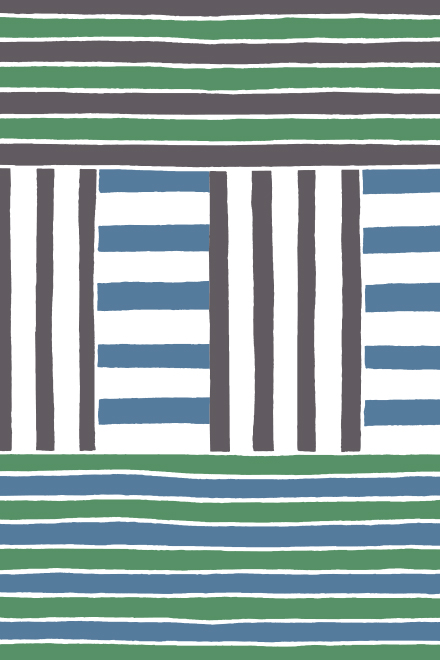
縞を組み合わせただけだが、
あまり見ない不思議な縞模様になった。
模様というのは面白いもので、何でもないものも、
組み合わせや間(ま)の取り方で全く新しいものに生まれ変わる。
考えてみるとこれはいろんなことにあてはまることかもしれない。
人と人も組み合わせ次第とも言える。
(脇阪 克二)
"Stripes"(2008,by Katsuji Wakisaka)
I arranged some common stripes into this unique wondering pattern.
This is what interests me when I picture textile designs:
By combining and leaving space,
Nothing becomes something.
All kinds of everything is in the same sense.
For instance, common people can unit into a remarkable team.
| English translation by LI XIAO XIAO |
"Rayures"(2008, par Katsuji Wakisaka)
Il s’agit simplement d’un ensemble de bandes mais il en résulte
Un motif à rayures étrange, peu vu jusqu’à présent.
Les motifs sont vraiment intéressants, des petites choses de rien du tout.
L’association de combinaisons et d’intervalles donne naissance à de nouvelles choses.
En y réfléchissant bien, cela peut s’appliquer à tout un tas de domaines.
Cela dépend également de l’association entre différents êtres, pourrait-on dire.
| Traduction française par Jean-Baptiste Fauvel Matsumoto |
"條紋"(2008, 脇阪 克二)
這個圖案雖然只是條紋的排列組合,
但卻有一種獨特而不可思議的魅力。
紋樣這種東西非常有趣,
平凡無奇的線條通過排列組合、適當留白和間隔,
就能組合成全新的模樣。
仔細想來,萬事萬物莫過如此,人也不例外。
| 中譯 : 李 瀟瀟 |
→こちらのテキスタイルデザイン商品
(Textile products with this pattern)
平成29年07月01日 土曜日号
“ひまわり 平成29年”
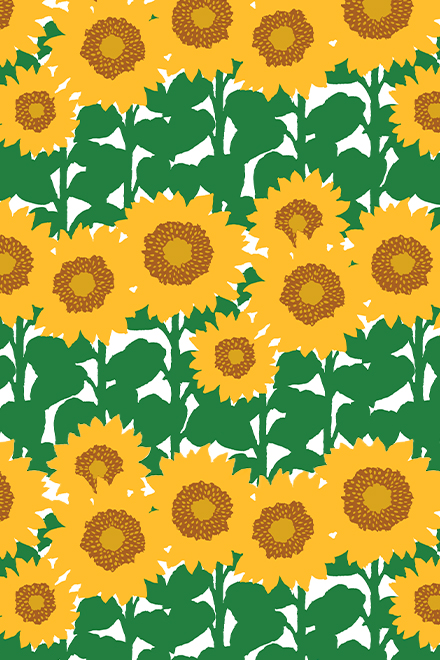
夏の太陽の恵みを精いっぱい
吸収しようと向きを太陽の方へ
変えつつ成長していくひまわり。
黄色い大輪の花を咲かせ
背が高くまっすぐ立つ姿は
明るく、力強く、元気づけられる。
又、種子は食用や油の原料として
貴重なものだ。
(脇阪 克二)
"Sunflower"(2017,by Katsuji Wakisaka)
Sunflowers turn their faces toward the sun.
Stretching, to absorb energy of the summer sun.
These big yellow flowers bloom,
Standing straight, bright and vigorous, cheer me up.
Seeds are also valuable, as food, or ingredient of oil.
| English translation by LI XIAO XIAO |
"Tournesol"(2017, par Katsuji Wakisaka)
Tournesol, qui tente d’absorber les bienfaits des rayons estivaux,
Tu grandis en te tournant doucement vers le soleil.
Avec tes grandes fleurs jaunes, de toute ta hauteur
Ta forme droite, radieuse et vigoureuse, nous donne de l’énergie.
De plus, tes graines sont très précieuses,
Sous forme d’ingrédients de cuisine ou d’huile.
| Traduction française par Jean-Baptiste Fauvel Matsumoto |
"向日葵"(2017, 胁阪 克二)
向日葵朝向太陽,
用力吸取夏日的所有恩賜。
長高,長大,開出大朵黃色的花。
向日葵筆挺站立,朝氣蓬勃,給人勇氣。
種子也是珍貴的東西,可供食用或成為油的原料。
| 中译 : 李 瀟瀟 |
→こちらのテキスタイルデザイン商品
(Textile products with this pattern)
平成29年06月28日 水曜日号
“人文字 平成29年”


昔からある人文字。
そういえば 江戸時代
歌川国芳は猫で文字を描いていた。
いざ 人文字を描いてみると
実際には出来ないポーズが出て来る。
しかし それはそれで
絵の良さでもあって 面白い。
僕のテキスタイルデザインは
いつも現実と空想が入り混じっている。
自由自在な人文字で
京言葉を描いてみた。
(脇阪 克二)
"Human letters"(2017,by Katsuji Wakisaka)
Human letters in Japan has a long history.
In Edo period (1603–1868),
Utagawa Kuniyoshi, a master of ukiyo-e wood block print created cat letters.
I tried to picture human letters but found that some poses I sketched are physically impossible for human to do.
Anyway, I saw it as enjoyment of painting.
My textile design is always mix up with reality and fantasy.
This time, I describe Kyo language through portraying vigor human letters.
| English translation by LI XIAO XIAO |
"Hitomoji / Lettres à forme humaine"(2017, par Katsuji Wakisaka)
Les caractères humain, depuis toujours. À l'époque d’Edo, Kuniyoshi Utagawa Écrivait ses caractères à partir de chats. En s'essayant à ce type de procédé, On s'aperçoit qu'en réalité certaines poses Sont impossibles à réaliser. Mes designs textiles sont toujours un savant Mélange entre réalité et fantaisie. En prenant librement ces lettres à forme humaines J'ai écrit des mots à la Kyotoite.
| Traduction française par Jean-Baptiste Fauvel Matsumoto |
"人文字"(2017, 胁阪 克二)
日本自古就有人文字(用人體排成文字的形狀),
江戶時代的浮世繪大師歌川國芳就曾用貓排出文字。
創作人文字,會畫出一些真人無法擺出的姿勢。
而這也是繪畫有趣的一面。
我作的織紋設計,多融合了現實與想像的元素。
這次嘗試用自由自在的人文字,描繪京都話。
| 中译 : 李 瀟瀟 |
→こちらのテキスタイルデザイン商品
(Textile products with this pattern)
平成29年06月26日 月曜日号
“見えかくれ 平成27年”
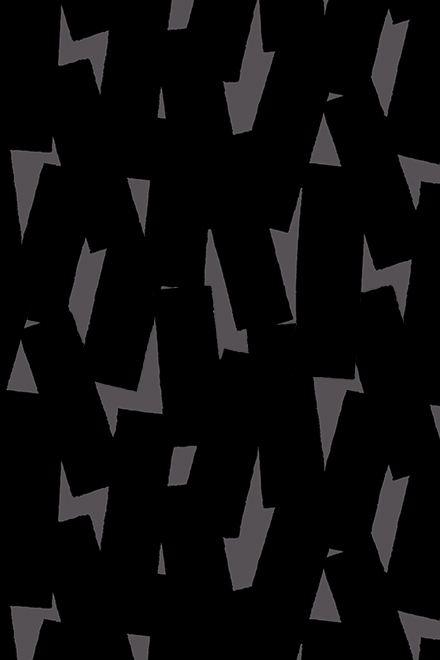
この柄は見方によって
違ったものが見える。
単純化された生きものみたいな形が
見えたり 長方形が見えたりする。
考えてみると
全ての物事は意識の仕方によって
見えるものが違ってくるのかもしれない。
(脇阪 克二)
"Flickering"(2015,by Katsuji Wakisaka)
This pattern takes on different shapes by changing the point of view.
You could see it as a picture of simplified creatures,
Or just some rectangles.
Things change depending on how you see them.
| English translation by LI XIAO XIAO |
"Effet d’optique"(2015, par Katsuji Wakisaka)
Ce motif change de forme
en fonction de la façon dont on le regarde.
On peut y voir une sorte d’être vivant simplifié
Ou bien un habit de forme rectangulaire.
En y réflechissant bien,
Il se peut que toutes les choses que nous voyons
Diffèrent en fonction de sa propre logique.
| Traduction française par Jean-Baptiste Fauvel Matsumoto |
"忽隱忽現"(2015, 胁阪 克二)
這件織物花紋,
從不同角度能看出不同的模樣。
既可以看作簡化的生物形狀,
也可以說它們只是疊加的幾何長方形。
萬事皆如此,
視角不同認識也不同。
| 中译 : 李 瀟瀟 |
→こちらのテキスタイルデザイン商品
(Textile products with this pattern)
平成29年06月24日 土曜日号
“拍子木 平成19年”
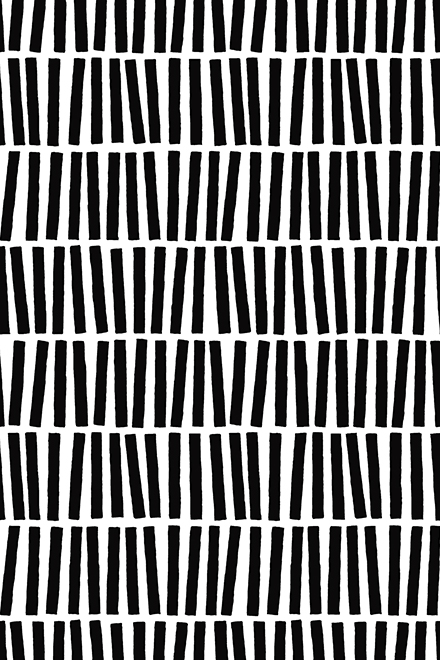
長方形をまっすぐ並べていっても
模様になるけれど、少しずつ
角度を変えて並べていくと
あるリズム感が出てきた。
それかこの模様の魅力になっている。
(脇阪 克二)
"Rhythmical clappers"(2008,by Katsuji Wakisaka)
Even line up rectangles can make a pattern.
I change their angles slightly when arranging them in line,
That brings a rhythm, and gives unique charm to this textile design.
| English translation by LI XIAO XIAO |
"Plaquette de bois"(2008, par Katsuji Wakisaka)
Même en alignant droit des rectangles
On peut obtenir un motif mais,
En changeant légèrement leurs angles,
Il en ressort un rythme singulier,
Qui en devient l’attrait de ce motif.
| Traduction française par Jean-Baptiste Fauvel Matsumoto |
"節拍木板"(2008, 胁阪 克二)
若把長方形規矩地排列,也能作成一幅紋樣。
將長方形細微變換各種角度而排列,
這些小長方形彷彿變成了節拍木板,
賦予了整體的節奏感。
這也是這件紋樣的魅力所在。
| 中译 : 李 瀟瀟 |
→こちらのテキスタイルデザイン商品
(Textile products with this pattern)
平成29年06月21日 水曜日号
“寄木細工 平成27年”
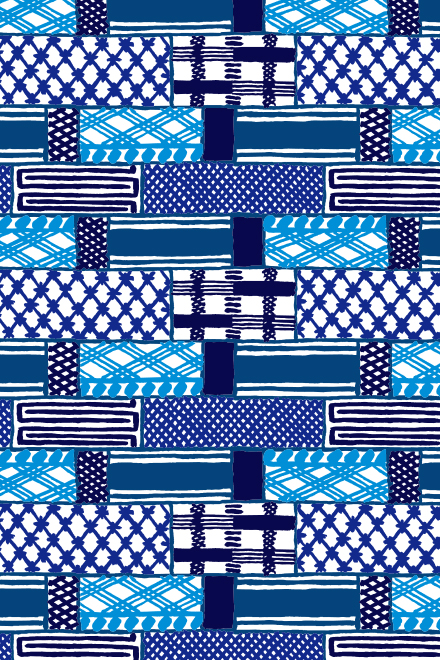
木質や木目、色の異なった木片を
組み合せ 接着して模様をつくる。
それを箱や引き出し、お盆などに
していく。
細かく緻密な細工で
独特の装飾性が楽しめる。
(脇阪 克二)
"Wooden mosaic"(2015,by Katsuji Wakisaka)
Yosegi-zaiku or wooden mosaic is a type of traditional Japanese parquetry that cut and glue timbers of different grains, textures and colors together to form patterns.
It is commonly used to decorate handicraft works such as boxes, drawers and plates.
Isn’t yosegi-zaiku a detailed and fascinating art?
| English translation by LI XIAO XIAO |
"Yosegi-zaiku / Marqueterie traditionnelle"(2015, par Katsuji Wakisaka)
Construire des motifs en collant plusieurs assemblages de bois aux qualités, grains et couleurs différents.
De ces motifs sont créés des boîtes, des tiroirs et des plats.
Avec un ouvrage minutieux et précis,
Nous pouvons apprécier une sensibilité ornementale unique.
| Traduction française par Jean-Baptiste Fauvel Matsumoto |
"寄木細工"(2015, 胁阪 克二)
將不同木質,木紋,顏色的木片拼合粘結構成圖案,
用來拼嵌裝飾箱子,抽屜,托盤等。
緻密的木片鑲嵌工藝具有其獨特的裝飾性。
| 中译 : 李 瀟瀟 |
→こちらのテキスタイルデザイン商品
(Textile products with this pattern)
平成29年06月17日 土曜日号
“七変化 平成21年”
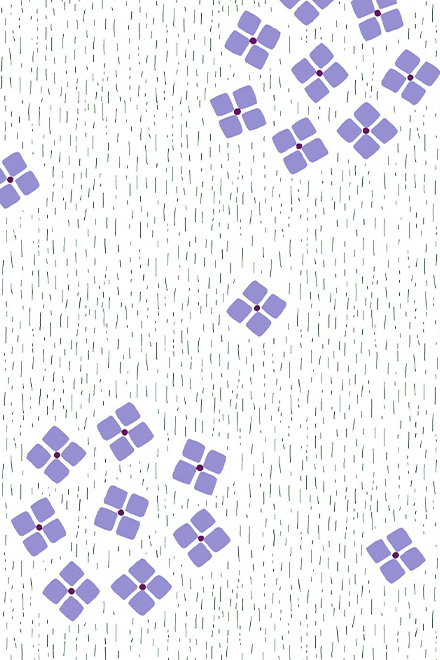
梅雨どき、花の少ない時期にしっとりとしかし鮮やかに咲き、
ともすれば沈みがちになる気持ちを
さわやかにしてくれる紫陽花。
ブルーから紫、ピンクまで微妙な色のバリエーションで
目を楽しませてくれる。
そのため七変化とも呼ばれる。
しとしと降る雨とシンプルな紫陽花で六月の情緒を。
(脇阪 克二)
"Hydrangea rainbow masquerade"(2009,by Katsuji Wakisaka)
Rainy season, few flowers bloom.
Hydrangea burst in the rain,
Bright and enchanting,
Light up our gloomy mood.
It varies in color, from blue to purple and pink.
That’s why we call it rainbow masquerade.
Drizzling rain and simple hydrangea composed a seasonal poem of June.
| English translation by LI XIAO XIAO |
"Shichihenge / “les septs variations"(2009, par Katsuji Wakisaka)
Pendant la période des pluies si humide, avec si peu de fleurs,
L’hortensia fleurit intensément pour nous rafraîchir et apaiser nos coeurs moribonds.
De bleu à violet, en passant par le rose, elle nous divertit avec
Son panel de couleurs si vaste et varié.
C’est pourquoi on l’appelle “Shichihenge”, littéralement “les septs variations”.
Une simple hortensia et la pluie, un air de juin.
| Traduction française par Jean-Baptiste Fauvel Matsumoto |
"七變化"(2009, 脇阪 克二)
在梅雨季節綻放的爲數不多的花中
紫陽花(綉球花)開得格外明媚
藍色,紫色,粉色的繽紛配色
讓這個時期人們沉鬱的心情豁然開朗
因此在日本紫陽花也被稱為「七變化」
這幅織紋用綫條表現綿綿不斷的梅雨
加之簡潔輪廓的紫陽花
表現六月獨有的景色與情緒
| 中譯 : 李 瀟瀟 |
→こちらのテキスタイルデザイン商品
(Textile products with this pattern)
平成29年06月14日 水曜日号
“優 平成24年”
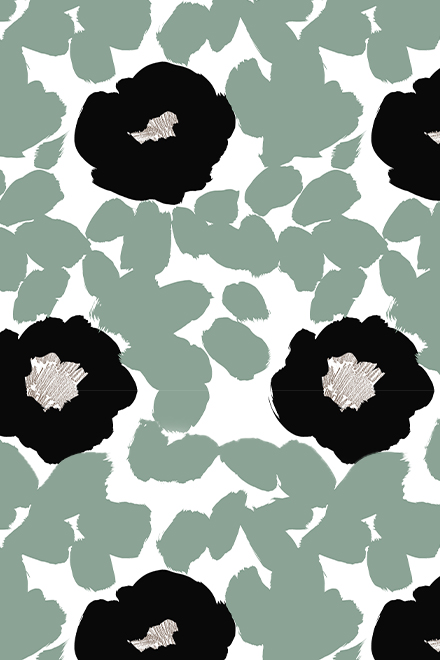
花は美しい、華やかだし生き生きしている。
花を見ているとなぐさめられ
はげまされ生きる喜びがわいてくる。
そして何より
人はその優しさに心魅かれる。
(脇阪 克二)
"Yu / Tender"(2012,by Katsuji Wakisaka)
Flowers are gorgeous, bright and lively.
They comfort me, encourage me, teaching me the joy of living.
Above all, men are attracted by these tender lives.
| English translation by LI XIAO XIAO |
"L'excellence"(2012, par Katsuji Wakisaka)
Les fleurs sont belles, resplendissantes et vivantes.
Regarder des fleurs est réconfortant, nous exhortant
Et nous rappelant les joies de la vie.
Et surtout, Les hommes sont attirés par cette excellence.
| Traduction française par Jean-Baptiste Fauvel Matsumoto |
"優"(2012, 胁阪 克二)
花優雅,華麗,充滿生機。
花治愈我,激勵我,讓我感受到生命的喜悅。
花柔和,人會因為這份溫柔而內心顫動。
| 中译 : 李 瀟瀟 |
→こちらのテキスタイルデザイン商品
(Textile products with this pattern)
平成29年06月11日 日曜日号
“甘とうがらし 平成27年”
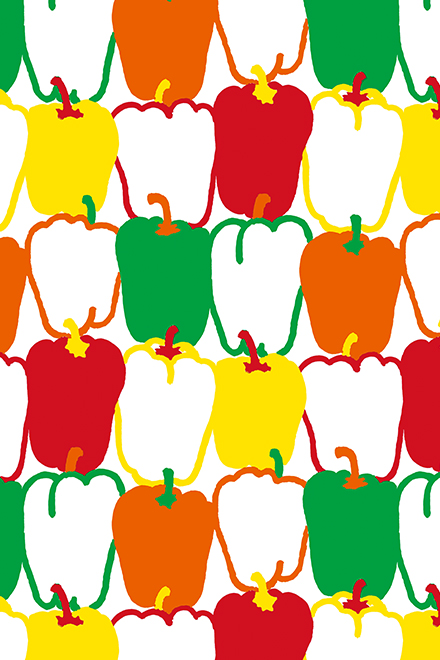
ふつうパプリカと呼ばれていて
とうがらしの一種だが
肉厚で辛味がなく甘い品種。
赤、オレンジ、黄、緑と
カラフルな色で目も楽しませてくれる。
暑い時に食べると
歯ごたえの良さと適度な甘みが
元気を与えてくれる。
(脇阪 克二)
"Ama-tougarashi"(2015,by Katsuji Wakisaka)
Normally it is called paprika.
Although it is one of the tougarashi (capsicum),
it's thick, and sweet taste not spicy.
Red, orange, yellow and green.
It is fun to just see.
When you eat it in a hot day,
It gives you vital with its light crunchy texture and modest sweetness.
| English translation by YUKA MAMEKOSHI|
"Ama Tōgarashi / Piments doux"(2015, par Katsuji Wakisaka)
Communément appelé paprika
Et faisant partie des piments,
Sa chair épaisse est sucrée, non piquante.
De couleurs diverses comme le rouge,
L'orange, le jaune ou le vert, il est un plaisir à voir.
Lorsqu'on en prend quand il fait chaud,
Sa texture agréable et sa douceur légère
Nous redonnent de l'énergie.
| Traduction française par Jean-Baptiste Fauvel Matsumoto |
"燈籠椒"(2015, 胁阪 克二)
燈籠椒,也稱菜椒,是辣椒的一種。
果肉厚實,無辣味,甚至帶有些許甜味。
外表多呈紅,橙,黃,綠等顏色,繽紛俏皮。
炎熱的季節食用,口感和恰到好處的甜味讓人元氣滿滿。
| 中译 : 李 瀟瀟 |
→こちらのテキスタイルデザイン商品
(Textile products with this pattern)
平成29年06月07日 水曜日号
“天のしずく 平成23年”
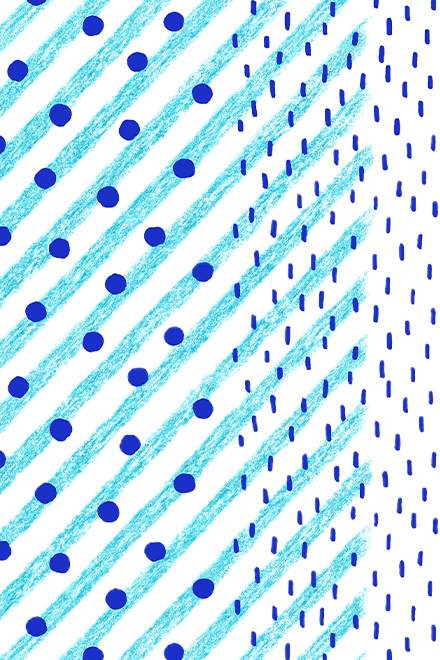
六月になると梅雨も近く雨の季節に入る。
しとしとと連日のように雨が降り続き、
気持ちも沈んでくる。でも見方を変えてみると、
グレイの空に透明なストライプや水玉が
降ってくる状景はとてもしゃれている。
そして雨が降らなければ、植物は育たないし、人は生きられない。
(脇阪 克二)
"Heavenly drops"(2011,by Katsuji Wakisaka)
Tsuyu, or plum rain, is the rainy season in Japan that starts around the beginning of June.
The drizzling rain sometimes makes me feel a bit blue.
But when I perceive it differently, I found it charming and stylish.
It’s like a sketch of numerous transparent stripes and drops falling from the gray sky.
These heavenly drops cultivates plants and bring up creatures.
| English translation by LI XIAO XIAO |
"Les larmes du ciel"(2011, par Katsuji Wakisaka)
En Juin, le Japon rentre dans sa saison des pluies. Les jours humides sous la pluie se succèdent, alourdissants notre humeur. En y prêtant plus attention, on se rend compte que les gouttes de pluie tombantes sous un ciel gris rayé de bandes transparents en font un tableau des plus élégants. De plus, sans eau, point de verdure, point de vie.
| Traduction française par Jean-Baptiste Fauvel Matsumoto |
"天之水滴"(2011, 胁阪 克二)
六月,梅雨將至。
連日雨綿綿,情緒也低沉起來。
但是換個角度看,
透明的細線和寶石從灰色的天空揮毫而下,
不失為一幅的有情調的畫面。
更是因為有了這場綿延的雨,植物才得以生長,人也得以生存。
| 中译 : 李 瀟瀟 |
→こちらのテキスタイルデザイン商品
(Textile products with this pattern)
平成29年06月03日 土曜日号
“くちなし 平成29年”
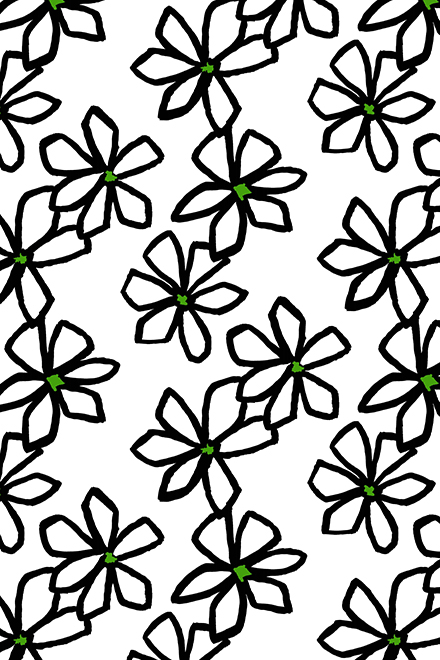
花は白、花弁はやや角ばった
ものが 6枚。
6-7日ごろに開花し
ジャスミンのような強い芳香がある。
ひっそりと静かに咲いている
印象がある。
(脇阪 克二)
"Cape jasmine"(2017,by Katsuji Wakisaka)
Cape jasmine, white flowers,
6 pieces of jagged petals,
The buds wait for 6 or 7 days to bloom,
Giving off a strong fragrance like jasmine.
Cape jasmine conveys me the impression that blossoming in silence.
| English translation by LI XIAO XIAO |
"Gardénia"(2017, par Katsuji Wakisaka)
Gardénia, fleur blanche,
6 pétales de forme anguleuse.
Elle met 6 à 7 jours afin de fleurir
Et répand son fort parfum comme le jasmin.
Elle fleurit silencieusement et calmement.
Elle marque les esprits.
| Traduction française par Jean-Baptiste Fauvel Matsumoto |
"梔子花"(2017, 胁阪 克二)
梔子花雪白,花瓣6片,稍有棱角。
含苞6,7天開花。
有茉莉花般強烈芳香。
在我印像中它們總是靜靜綻放。
| 中译 : 李 瀟瀟 |
→こちらのテキスタイルデザイン商品
(Textile products with this pattern)
平成29年05月31日 水曜日号
“わらべぎ 平成23年”
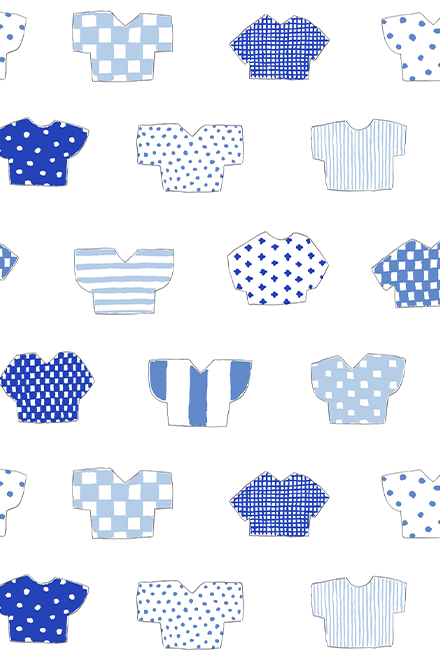
わらべぎはシンプルなものから
遊び心いっぱいのもの、
シックなものから大胆なものまで
いろいろあっていい。
こんな服を着た子どもが遊んでいたら、
かわいいことだろう。
(脇阪 克二)
"Children’s clothes"(2011,by Katsuji Wakisaka)
Children’s clothes,
Some are simple, some are playful,
Some look chic, some look bold.
Kids dressing these various clothes and playing around.
Isn’t it a heartwarming scene?
| English translation by LI XIAO XIAO |
"Warabegi "(2011, par Katsuji Wakisaka)
Le Warabegi est simple, ludique,
À la fois chic et audacieux.
Les enfants s’amusant en portant cet habit
Ne sont-ils ps mignons?
| Traduction française par Jean-Baptiste Fauvel Matsumoto |
"童裝"(2011, 胁阪 克二)
童裝有簡單的,也有玩心大發的,
有著色沈穩的,也有鮮豔大膽的。
小孩們穿著這些各式各樣的衣服玩耍,
多可愛的場景啊。
| 中译 : 李 瀟瀟 |
→こちらのテキスタイルデザイン商品
(Textile products with this pattern)
平成29年05月29日 月曜日号
“花押 平成29年”


元々は文書に自ら署名を
していたが
署名者本人と他者を区別するため
次第に図案化、文様化してきて
うまれた花押。
平安の昔から使われてきたが
ここにあるのは戦国武将のもの
一見 どこの国のものかな?と
思いませんか。
(脇阪 克二)
"KAO signature"(2017,by Katsuji Wakisaka)
KAO were stylized identification signatures used to distinguish between principal and others.
KAO signature is a unique pattern and began to be used in Japan since the Heian period.
I arranged some KAO of Busho (military commander) of the Sengoku (Warring States) period to create this textile design.
Take a glance and can you figure out what countries are they represent for?
| English translation by LI XIAO XIAO |
"Sceau"(2017, par Katsuji Wakisaka)
Autrefois, les japonais signaient
De leur propre nom leurs écrits.
Pour différencier le véritable auteur d’une tierce personne,
Ces signatures furent graduellement
modélisées et patronnées, donnant naissance au sceau.
Utilisés dès la période Heian (794-1185),
Celui-ci date de l’Ère Sengoku (XVème siècle).
En regardant de plus près, ne vous demandez-vous pas
D’où il peut bien parvenir?
| Traduction française par Jean-Baptiste Fauvel Matsumoto |
"花押"(2017, 胁阪 克二)
花押是代替簽名的一種簽署形式,
為了使簽名個性化,
有時會加入一些符號,發展為一種獨特紋樣。
花押早在平安時代傳入日本,
我所作的這幅紋樣中主要使用的是戰國武將的花押。
你不妨觀察一下,它們分別是諸國中哪些國家的花押呢?
| 中译 : 李 瀟瀟 |
→こちらのテキスタイルデザイン商品
(Textile products with this pattern)
平成29年05月27日 土曜日号
“牡丹 平成19年”
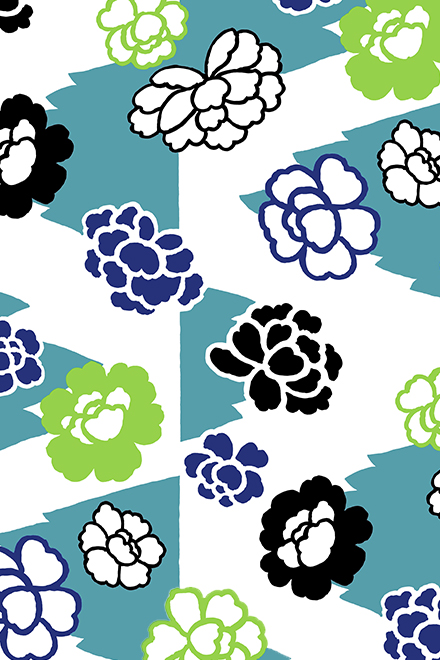
立てば芍薬(しゃくやく)、座れば牡丹、歩く姿はゆりの花。
これは昔の美人を表す慣用句だった。
牡丹は華やかで美しく、模様にしても豪華。
(脇阪 克二)
"Lily"(2007,by Katsuji Wakisaka)
There is a metaphorical expression for beauties in Japan--
”She sits and stands a peony and walks a lily.”
Lily is gorgeous, so also is as a pattern of textile design.
| English translation by LI XIAO XIAO |
"Pivoine"(2007, par Katsuji Wakisaka)
Debout, tel un pivoine; Assise, tel un pivoine arbuste; Marchant, tel un lys.
Il s’agit d’une ancienne expression pour exprimer la beauté d’une femme.
Le pivoine est splendide et magnifique, en fleur comme en motif.
| Traduction française par Jean-Baptiste Fauvel Matsumoto |
"牡丹"(2007, 胁阪 克二)
日語中有種說法,
“立如芍藥,坐如牡丹,行走如百合。”
古時常用來形容美女。
牡丹富麗而美,設計成織物紋樣也是華貴端莊。
| 中译 : 李 瀟瀟 |
→こちらのテキスタイルデザイン商品
(Textile products with this pattern)
平成29年05月23日 火曜日号
“疏水 平成17年”
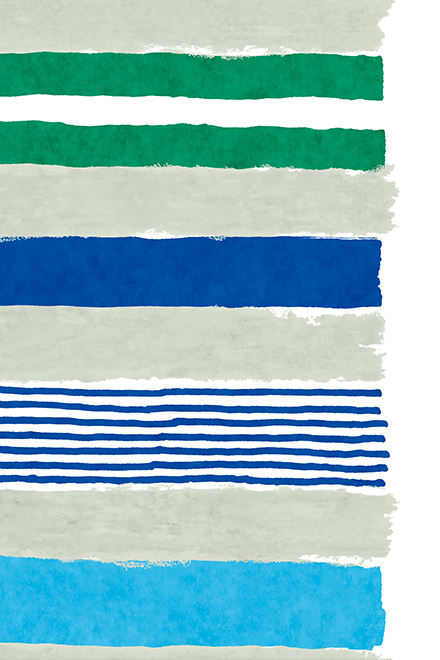
毎朝散歩する南禅寺界隈は疏水がいたるところにあり、
流れにそった道を歩いているとせせらぎが
胸にひびいていくる。このあたりの別荘も
疏水からの水で庭に流れをつくり池をつくっている。
この疏水は琵琶湖からトンネルをくぐり
水道橋を渡ってきて京都の町を潤している。
(脇阪 克二)
Lake Biwa canal"(2005,by Katsuji Wakisaka)
I take a walk around Nanzenji temple every morning.
There is a small canal flows along.
Murmur of the stream, sounds like a song.
Houses around there, people make a pond or water situated in their garden.
This canal flowing through elevated aqueduct, providing Kyoto with water from Lake Biwa.
| English translation by LI XIAO XIAO |
"Canal"(2005, par Katsuji Wakisaka)
Dans l’enceinte du Nanzenji, où je me promène
tous les matins, se trouve un petit canal.
Lorsque je marche sur le chemin le longeant,
Son courant résonne en moi, tel un chant.
Le canal alimente également les jardins et les étangs
des maisons des alentours.
Ce courant vient directement du lac Biwa, via un tunnel
| Traduction française par Jean-Baptiste Fauvel Matsumoto |
"疏水"(2005, 胁阪 克二)
我每天清晨會去南禪寺散步,
附近有琵琶湖疏水流過。
那潺潺流水每日迴盪於心。
這一帶的別墅山莊多引流疏水,順勢造園,造池。
疏水流過水道橋,為古都帶來潤澤。
| 中译 : 李 瀟瀟 |
→こちらのテキスタイルデザイン商品
(Textile products with this pattern)
平成29年05月17日 水曜日号
“糺の森 平成20年”
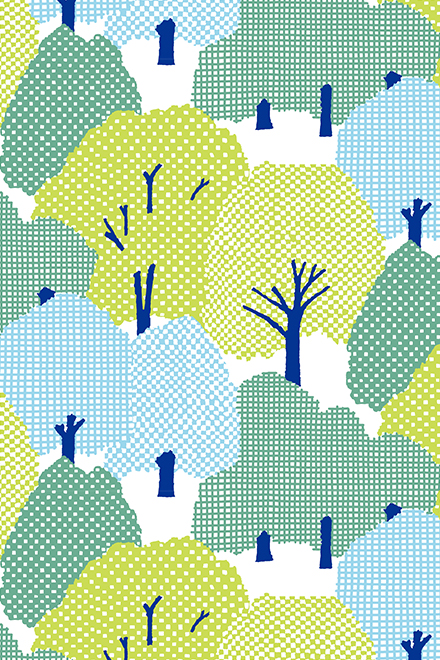
世界遺産となっている下鴨神社。
原生林の鎮守の森。木々がそびえ立っていて、
気持ちのいい空間が広がっている。
細かい市松や格子柄を使って、葉の濃淡や形の
微妙な変化を表現し、豊かで多彩な
森の感じが出せればと思った。
(脇阪 克二)
"Tadasu-no-mori"(2008,by Katsuji Wakisaka)
Shimogamo shrine is designated by UNESCO as a World Heritage Site.
It is surrounded by the Tadasu-no-mori, a forest contains trees that are up to 600 years old.
This place makes me feel relaxed.
By using these small checkered pattern,
I try to express contrasting density of leaves and subtle changes of the forest.
| English translation by LI XIAO XIAO |
"Tadashi no Mori"(2008, par Katsuji Wakisaka)
Le Sanctuaire Shimogamo, patrimoine mondial de l’UNESCO.
Une forêt vierge, déité locale. Les arbres s’élèvent majestueusement
Créant un espace agréable et vertueux.
A l’aide de damiers minutieux et de motifs de grilles,
Nous avons retranscrit les changements subtils de teinte des feuilles,
Avec l’espoir de véhiculer les richesses et couleurs de la forêt.
| Traduction française par Jean-Baptiste Fauvel Matsumoto |
"糺之森"(2008, 脇阪 克二)
京都的下鴨神社是世界遺産,
位于原生態林 「糺之森」的廣大腹地之中。
鎮守神社的古樹傲然挺立,葱郁怡人。
我在紙上用格子排列表現樹葉的濃淡,樹冠的形狀。
創作了這幅微妙變幻的「糺之森」。
| 中譯 : 李 瀟瀟 |
→こちらのテキスタイルデザイン商品
(Textile products with this pattern)
平成29年05月13日 土曜日号
“かきつばた 平成20年”
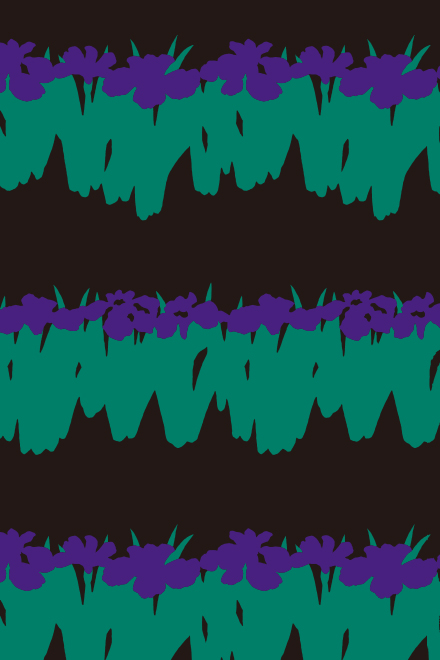
かきつばたとくれば尾形光琳の屏風の絵で決まりだろう。
このデザインは、その光琳の絵をもとに作らせてもらった。
究極の美しさを見てしまうと
僕がジタバタしてもはじまらないと思う。
(脇阪 克二)
"Iris"(2008,by Katsuji Wakisaka)
When it comes to Iris,
It recalls the image of Irises screen of Ogata Korin.
This textile design is just based on Korin’s work.
It’s of ultimate beauty that is beyond my grasp.
| English translation by LI XIAO XIAO |
"Iris"(2008, par Katsuji Wakisaka)
Quand on parle d’Iris, il est évident qu’on pense
Au célèbre paravent de Ogata Korin.
Ce design s’inspire de l’oeuvre de Korin.
A la vue d’une telle beauté si extrême,
Je pense qu’il est inutile de résister.
| Traduction française par Jean-Baptiste Fauvel Matsumoto |
"杜若"(2008, 胁阪 克二)
一提到杜若,首先浮現出的是尾形光琳創作的屏風。
這幅布樣設計這是基於光琳的畫而作的。
原作美到極致,
我再怎麼加以創作也是鞭長莫及。
| 中译 : 李 瀟瀟 |
→こちらのテキスタイルデザイン商品
(Textile products with this pattern)
平成29年05月10日 水曜日号
“芍薬(しゃくやく) 昭和56年”
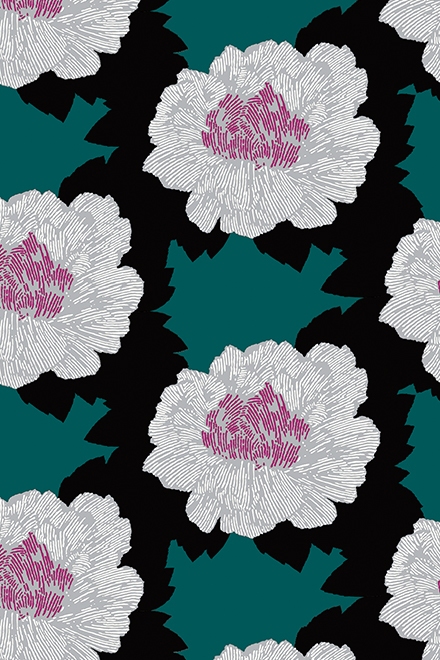
丸く張った つぼみは コロンとして
いて かわいい。
時と共に固く とじたつぼみは
恥じらうように 少しずつ開きはじめる。
そして一気に大きく開花する。
開花すると 牡丹の様に
あでやかな姿に変身する。
(脇阪 克二)
"Peony"(1981,by Katsuji Wakisaka)
Little buds of peony,
Round and cute,
Start blooming like some shy girls.
Suddenly, they burst into bloom all at once,
Those adorable girls turned into fascinating women.
| English translation by LI XIAO XIAO |
"Pivoine"(1981, par Katsuji Wakisaka)
Mignon petit bourgeon tout rond.
Avec le temps, d'un air gêné,
il s'ouvre petit à petit au monde.
Puis d'un coup, il fleurie totalement.
À sa floraison, tel un pivoine, Il se transforme magnifiquement.
| Traduction française par Jean-Baptiste Fauvel Matsumoto |
"芍藥"(1981, 胁阪 克二)
芍藥花蕾,輪廓圓潤可愛。
蓓蕾似少女含羞,徐徐綻放。
一瞬間綻開大朵的花。
盛放的芍藥似牡丹,
嬌豔而熱烈。
| 中译 : 李 瀟瀟 |
→こちらのテキスタイルデザイン商品
(Textile products with this pattern)
平成29年05月06日 土曜日号
“草枕 平成24年”
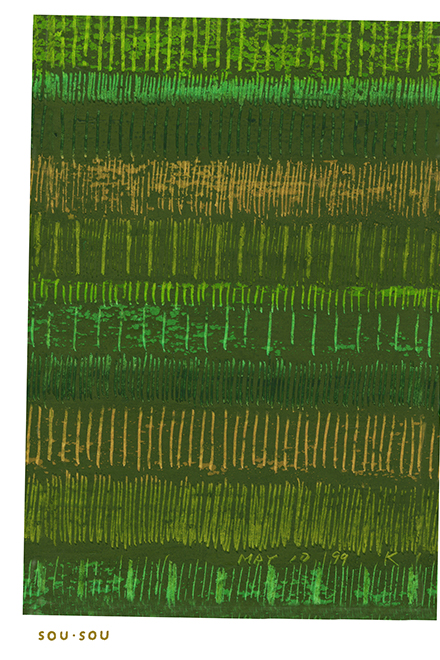
昔旅に出て野宿するとき、草を束ねて
仮の枕をつくったことから、旅や旅で寝ることを
草枕というようになった。
草枕という言葉からは古の人達が生きてきた
時代のきびしさや淋しさがしのばれる。
そしてその中で人生を歩んでいた人達の姿が浮んでくる。
(脇阪 克二)
"Kusamakura / Grass pillow"(2012,by Katsuji Wakisaka)
Kusamakura literally means grass pillow, is that while travelling one uses the grass as a pillow to sleep outdoors.
This word reminds me the severe environment and loneliness of the old age,
And those people who live through that period of time.
| English translation by LI XIAO XIAO |
"Oreiller d'herbes"(2012, par Katsuji Wakisaka)
Autrefois, lorsqu'on dormait à l'extérieur lors de voyages,
on rassemblait de l'herbe pour en faire des oreillers.
De ce procédé est né le terme “Oreiller d’herbes”,
Traduisant les difficultés et la solitude que les gens de l'époque
éprouvèrent dans leur vie.
On peut également y entrepercevoir la silouhette de ces personnes qui y ont vécues.
| Traduction française par Jean-Baptiste Fauvel Matsumoto |
"草枕"(2012, 胁阪 克二)
舊時人們出行露宿,
編草作枕,安頓旅途睡眠,稱為“草枕”。
草枕一詞,讓人聯想到古代環境的嚴峻蕭然,
同時也浮現出在那樣的環境中人們努力生存的身影。
| 中译 : 李 瀟瀟 |
→こちらのテキスタイルデザイン商品
(Textile products with this pattern)
平成29年05月03日 水曜日号
“布芝空薔薇 平成18年”
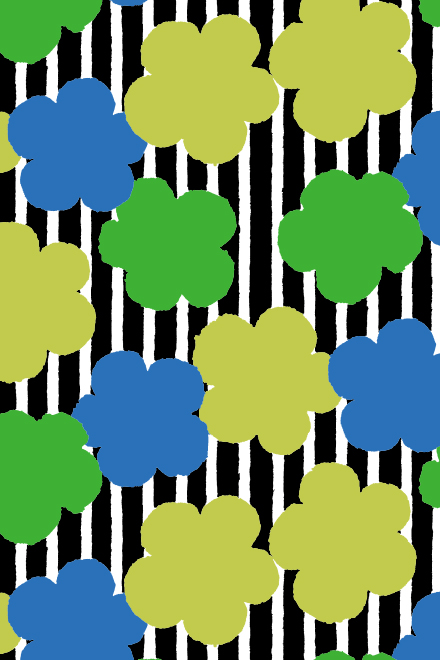
布はストライプの布
芝は緑の芝生
空は青い空
薔薇は薔薇園
ギャラリーprinzのためのデザイン。
ゆったりとした空間に
静かな時が流れている。
(脇阪 克二)
"Nuno-shiba-sora-bara / Woven roses"(2012,by Katsuji Wakisaka)
Nuno, refers to cloth with stripe pattern.
Shiba, means green grass.
Sora, the blue sky.
Bara, the rose garden.
This pattern is designed for Prinz gallery.
Time passes slowly in that relaxed atmosphere.
| English translation by LI XIAO XIAO |
"Nuno-shiba-sora-bara"(2012, par Katsuji Wakisaka)
Nuno, pour le tissu à motif à rayures
Shiba, pour la pelouse verte
Sora, pour le ciel bleu
Bara, pour la roseraie
Ce design, pour la galerie prinz.
Dans cet espace paisible
S'écoule calmement le temps.
| Traduction française par Jean-Baptiste Fauvel Matsumoto |
"布芝空薔薇"(2012, 脇阪 克二)
「布」是條紋布,
「芝」指綠草坪,
「空」為湛藍天,
「薔薇」是玫瑰園。
這是我為畫廊prinz所繪的織紋設計。
在畫廊靜谧的空間裡,
時光潺潺流淌。
| 中譯 : 李 瀟瀟 |
→こちらのテキスタイルデザイン商品
(Textile products with this pattern)







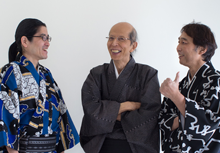

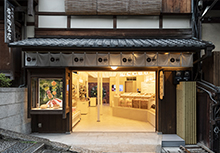

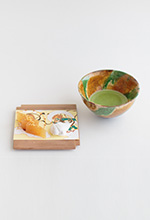
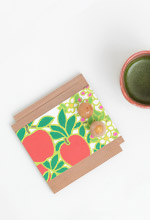
 お問い合わせ窓口
お問い合わせ窓口